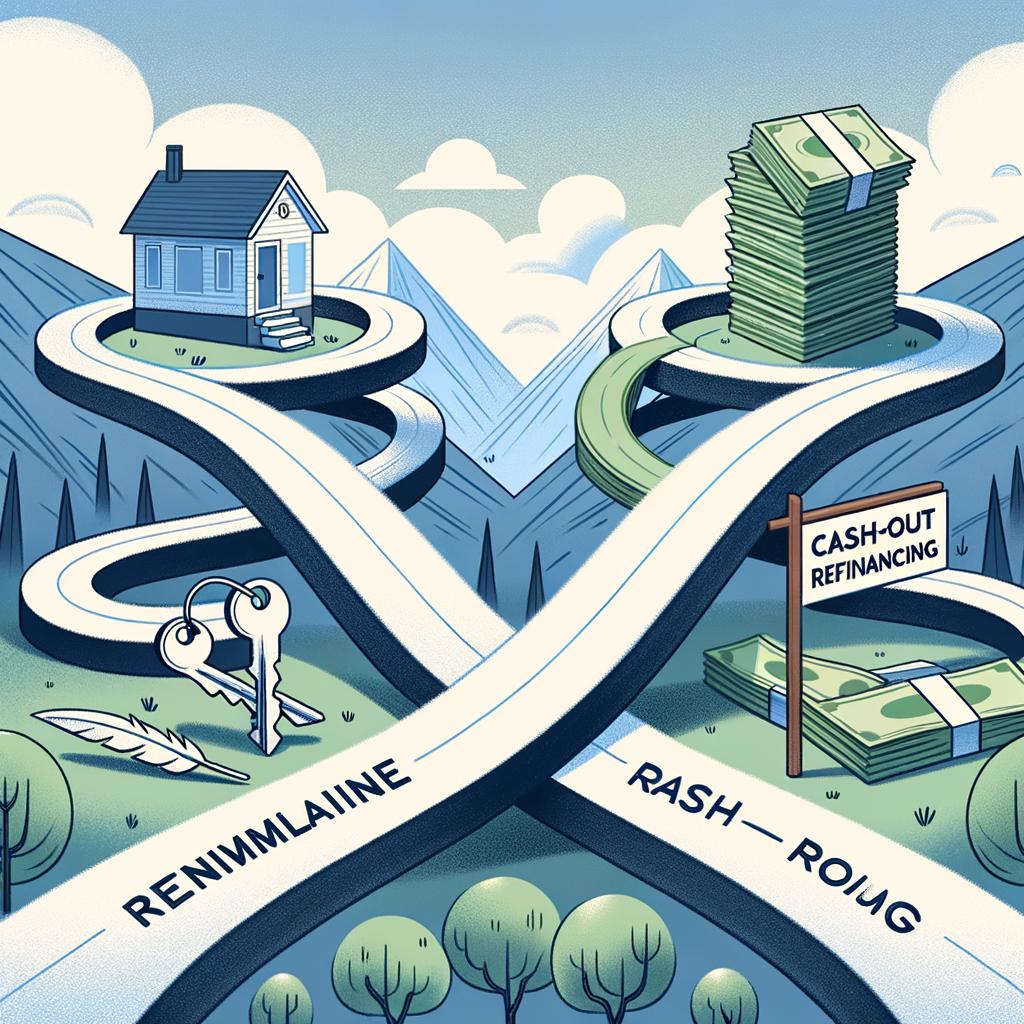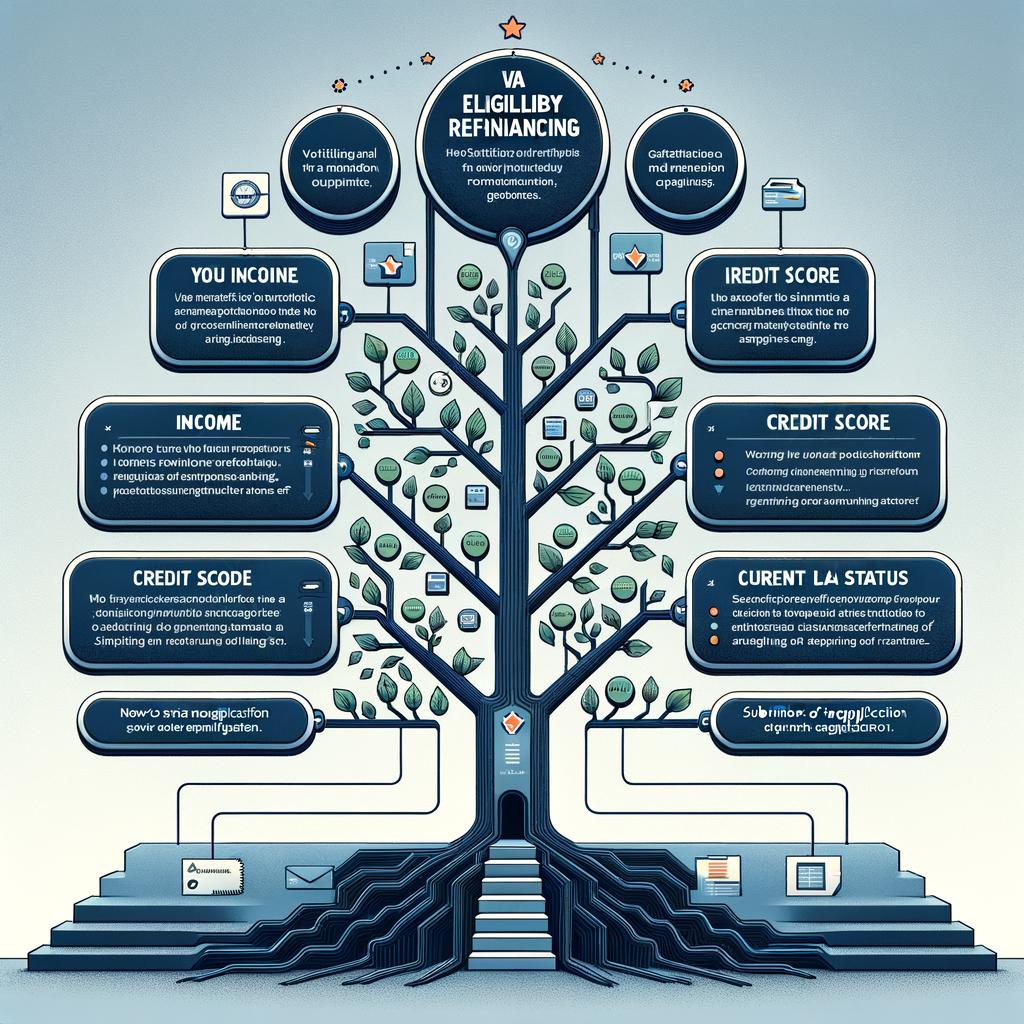In the intricate dance of homeownership, military service members and veterans are offered a unique partner: the VA loan. This special financing tool is not only a token of gratitude for their service but a practical pathway to owning a home without the steep barriers that often trip up civilians. However, even the most heroic of us can find the landscape of mortgage refinancing a complex battlefield. As we delve into the world of VA loan refinancing, consider this guide your strategic map, charting the course through interest rate reductions, streamlined processes, and cash-out options. Whether you’re a seasoned homeowner or a first-time buyer in uniform, understanding how military mortgages work could make a monumental difference in your financial future. Join us as we unpack the essentials of VA loan refinancing, navigating through the fog of financial jargon and regulatory requirements to clear the path to your home financing goals.
Table of Contents
- Understanding the Basics of VA Loan Refinancing
- Exploring the Benefits of Streamline and Cash-Out Refinancing Options
- Navigating Eligibility and Application Steps for VA Refinancing
- Maximizing Your Benefits with Expert Tips and Common Pitfalls to Avoid
- Future Outlook

Understanding the Basics of VA Loan Refinancing
For many veterans and active military members, VA loans represent a cornerstone of their financial strategy when purchasing a home. However, as economic conditions and personal situations evolve, refinancing these loans becomes an equally important consideration. Here, we delve into the world of VA loan refinancing, providing a streamlined understanding to help you navigate your options effectively.
Refinancing your VA loan isn’t just about getting a lower interest rate; it can also help manage your home equity, reduce your monthly payments, or change the loan term. Specifically, there are two primary types of VA loan refinancing: the Interest Rate Reduction Refinance Loan (IRRRL) and the VA Cash-Out Refinance. Each serves different needs and comes with its unique set of benefits and considerations.
The Interest Rate Reduction Refinance Loan (IRRRL), also known as the VA Streamline Refinance, is dedicated to lowering your existing VA loan interest rate. Its hallmark feature is the streamlined process: no need for a new certificate of eligibility, and in many cases, no new appraisal required either. This makes the IRRRL a cost-effective and relatively quick option for refinancing.
VA Cash-Out Refinance is the second option, allowing veterans to refinance their non-VA loan into a VA loan. This option not only refines your interest rate but also gives you the possibility to take cash out from your home’s equity. This can be crucial for major expenditures like home renovations, education, or consolidating debt.
Comparatively, choosing between these two can depend on your specific financial goals. Below is a simple table that outlines the basic differences:
| Refinance Type | Primary Benefit | Best Used For |
|---|---|---|
The IRRRL is often a no-brainer if you qualify, as it generally leads to lower payments with less paperwork. Notably, it must result in a financial benefit to the borrower, either through reduced payments or a shift from an adjustable to a fixed-rate loan.
For the VA Cash-Out Refinance, it’s pivotal to assess the amount of equity in your home. Lenders typically allow you to borrow up to 100% of your home’s value, but this can vary based on lender standards and your financial profile. This type of refinancing often requires full underwriting, including income verification, credit check, and a new appraisal.
When considering either option, it’s important to take into account the associated costs. While the VA limits certain closing costs, both types of refinancing have fees that can include funding fees, appraisal fees, and possible early payment penalties on your current mortgage. Understanding these costs up front can help you calculate the break-even point and decide if refinancing makes sense financially.
Ultimately, the question of whether to refinance your VA loan comes down to specifics of your personal financial situation and the costs involved. It’s wise to consult with multiple lenders to compare offers and ensure you get the best rate possible. Additionally, consulting with a financial advisor who is familiar with VA loans can provide tailored advice that considers your long-term financial goals.

Exploring the Benefits of Streamline and Cash-Out Refinancing Options
Veterans and active military members looking to enhance the financial aspects of their home mortgages often find themselves exploring different refinancing options. Two popular choices are streamline refinancing and cash-out refinancing, both of which offer unique benefits tailored to suit varied financial situations. Understanding these options can lead to significant savings and increased flexibility in managing personal finances.
Streamline Refinancing, officially known as the Interest Rate Reduction Refinance Loan (IRRRL), is an expedient way to lower your monthly mortgage payments. This option is only available to those who already have a VA loan and primarily focuses on reducing the interest rate and by extension, the monthly payment. One of the key attractions of streamline refinancing is the reduced amount of paperwork and the absence of a need for an appraisal. Additionally, the closing costs can often be rolled into the total loan amount, ensuring out-of-pocket expenses remain low.
- Lower interest rates
- No appraisal necessary
- Minimal paperwork
- Potential to include closing costs in the loan
Cash-Out Refinancing involves replacing your existing loan with a new one for a higher amount than owed, allowing you to take the difference in cash. This option is appealing for those looking to consolidate debt, make home improvements, or cover other significant expenses. Borrowers do not need an existing VA loan to qualify, but they do need to certify that they will occupy the home. This form of refinancing can also serve to refinance a non-VA loan into a VA loan.
- Debt consolidation opportunities
- Cash on hand for large expenses or investments
- Ability to refinance non-VA loans into VA loans
One of the biggest differences between these two refinancing options lies in their eligibility requirements and benefits:
| Refinancing Type | Primary Benefit | Key Eligibility |
|---|---|---|
| Streamline | Lower Interest Rate | Existing VA Loan |
| Cash-Out | Access to Cash | Proof of Home Occupancy |
For military personnel considering the streamline option, it’s important to stress that this option is best suited when the prevailing market interest rate is lower than your current loan’s rate. Contrastingly, cash-out refinancing is an excellent tool when you need liquidity for large expenses, such as higher education, or home renovation projects.
Each refinancing type supports different aspects of financial wellbeing. Streamline refinancing is largely about reducing costs without cashing out equity, whereas cash-out refinancing provides financial leverage in exchange for equity. Deciding which is most beneficial will depend on your specific financial needs and long-term goals.
Considering these refinancing options can have significant impacts on your financial landscape. Military members and veterans should consult with a loan specialist who understands the intricacies of VA loans to ensure the chosen refinancing option aligns with their financial strategies and goals.

Navigating Eligibility and Application Steps for VA Refinancing
Understanding the eligibility criteria and application process for a VA loan refinance can streamline the transition from your current mortgage into a more cost-effective and manageable loan. Whether looking to lower your monthly payments or tap into your home’s equity, several steps are critical to follow. Here’s what you need to know to maneuver through the VA refinancing options, be it through the Interest Rate Reduction Refinance Loan (IRRRL) or through a Cash-Out refinance.
Eligibility Requirements
- Service and Duty: You must meet specific service length requirements or duty criteria, varying by service era. Eligibility also extends to spouses under certain conditions.
- Loan Limits: While VA loans themselves do not have a maximum loan amount, your entitlement and the lender’s criteria may affect the loan size.
- Primary Residence: The home being refinanced must be your primary residence. You must certify that you either live in the home currently or intend to move in within a reasonable period post-closing.
Steps to Apply for VA Refinancing:
The application process can be daunting, but breaking it down into manageable steps can ease the experience:
- 1. Certificate of Eligibility (COE): Begin by obtaining your COE through the VA’s eBenefits portal. This document verifies to lenders that you meet the minimum service requirements.
- 2. Choose the Type of Refinancing: Decide whether you want an IRRRL, which is simpler and requires no appraisal or underwriting, or a Cash-Out refinance to tap into your home equity.
- 3. Compare VA-Approved Lenders: Not all lenders handle VA loans or understand their unique aspects. Research and choose one experienced with VA refinancing.
- 4. Apply: Submit your application along with your COE, and any other documentation the lender requires. Typical documents include W2s, tax returns, and proof of income.
- 5. Underwriting: Once your application is submitted, it goes to underwriting. Here your financial health is assessed to ensure you meet the loan criteria.
- 6. Closing: Upon approval, you’ll close the loan. This process usually involves signing a lot of paperwork and possibly facing some closing costs, which can sometimes be rolled into the loan balance.
Cost Overview:
| Type of Cost | Detail |
|---|---|
| Funding Fee | Typically 0.5% for IRRRL or 2.3% for first-time use in Cash-Out refi |
| Appraisal Fees | Required only for Cash-Out refi, not for IRRRL |
| Closing Costs | Varies by lender, can be rolled into loan amount |
The opportunity to refinance your mortgage through a VA loan is a valuable benefit for veterans and active members of the military, allowing for potentially better financial terms and flexibility with your home financing. By familiarizing yourself with the eligibility requirements and the step-by-step process, you can navigate this journey with confidence. Remember, each refinance option serves different needs, so consider your long-term financial goals and current situation to choose the path that best aligns with your objectives.

Maximizing Your Benefits with Expert Tips and Common Pitfalls to Avoid
Refinancing a VA loan can provide significant financial benefits, but knowing how to navigate the process will help you maximize these advantages while avoiding common pitfalls. Here are expert tips and considerations to keep you informed along the way.
Review Your Current Mortgage
Before considering refinancing, thoroughly examine your existing mortgage. Look at your current interest rate, loan terms, and monthly payment. Assess whether the refinancing offer presents a true benefit, such as a lower interest rate or shorter loan term.
- Lower interest rates can significantly reduce monthly payments and the total amount paid over the life of the loan.
- Shorter loan terms, though possibly with higher monthly payments, can save money on interest in the long run.
Evaluate Different VA Refinance Options
There are primarily two types of VA refinance options: the Interest Rate Reduction Refinance Loan (IRRRL) and the VA Cash-Out Refinance. The IRRRL, often called a Streamline Refinance, is easier to qualify for and involves less paperwork. Contrastingly, the Cash-Out option is suitable if you want to take out cash against the equity of your home.
| Refinance Type | Benefits | Best For |
|---|---|---|
| IRRRL | Lower fees, faster processing | Borrowers with current VA loans looking for a better interest rate |
| Cash-Out | Access home equity, consolidate debt | Homeowners needing extra cash, those with other high-interest debts |
Understand the Costs
While VA loans often have lower associated costs than other types of refinancing, there are still fees and closing costs involved. These can include the VA funding fee, which is a percentage of the loan amount that varies based upon the nature of your service and the type of loan.
- Always request a full breakdown of costs before proceeding.
- Consider how long it will take you to recoup these costs through your monthly savings.
Check Your Credit Score
Even though VA loans are forgiving when it comes to credit scores, ensuring your credit is in good standing can provide better interest rates. Take steps to improve your credit score by paying down high credit card balances and making all current debt payments on time.
Utilize VA Refinance Calculators
Use online VA refinance calculators to help determine if refinancing your mortgage is financially beneficial. These tools can provide estimates on your new monthly payments, potential savings, and break-even period.
Avoid Frequent Refinancing
Each refinance comes with costs and may extend the amount of time you’re in debt. Turning to refinancing too often can also reflect poorly on your financial stability. Weigh the long-term benefits against the upfront expenses to make a well-informed decision.
Consult with Professionals
Lastly, it’s beneficial to consult with a mortgage advisor who understands the specifics of VA loans and can provide personalized advice based on your financial situation and goals. A seasoned professional can help you navigate complex choices and ensure that you obtain favorable terms while sticking to applicable legal requirements.
Future Outlook
As we conclude our journey through the landscape of VA loan refinancing, remember that this path, while paved with substantial benefits, demands careful navigation. Military mortgages, underpinned by honor and service, offer a gateway to homeownership that resonates with the values of sacrifice and commitment. Whether you’re taking the initial steps towards refinancing or seeking to delve deeper into the strategic advantages it provides, always consider how these financial tools can serve your unique situation as steadfastly as you have served. As you march forward, armed with knowledge and empowered by opportunity, let your dreams of home and hearth guide you. Forge ahead, knowing that each step on this path of refinancing is a stride towards securing your family’s sanctuary and your peace of mind. Remember, your journey in homeownership is not just about laying down roots, but about crafting a legacy that lasts.
